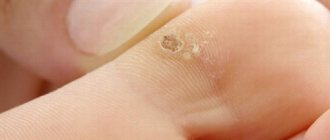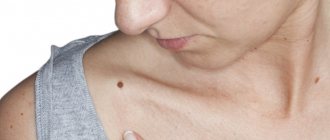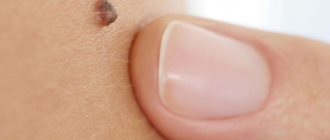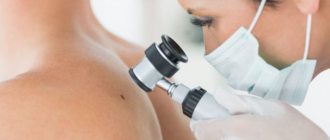Preparing to remove a wart
At the initial appointment, the doctor examines the patient and assesses the condition of his skin: the size and number of warts, skin type, thickness. At the same time, a survey is conducted to determine how long ago the wart was formed and the rate of its development.
If wart cell degeneration and other pathologies are suspected, the dermatologist will refer the patient for tests to determine the type of virus that provoked the formation of the growth.
Immediately before removing the wart, the patient should donate blood for the presence of HIV, syphilis, hepatitis B and C. There is no need for preoperative observation of the patient in the ward.
Indications for surgery
An indication for surgical treatment is the presence of a wart of any kind, especially if it is located in open areas and causes physical and psychological discomfort. Do not delay your visit to the surgeon if:
- the wart turns red, increases in size and hurts;
- suppuration, itching or burning appeared in the area of formation;
- the growth has been injured and is bleeding;
- the number of neoplasms increases;
- Conservative treatment methods do not give results.
Treatment tactics depend on the nature and type of tumor, quantity, location, size and duration of its existence.
How is wart removal performed surgically?
On the day appointed for the operation, the patient arrives at the clinic. Having received special sterile clothing, he changes clothes and goes to the operating room prepared for him. Excision of warts with a scalpel is a simple surgical operation. To carry it out, it is sufficient to use local anesthesia, which most often takes the form of an injection of lidocaine or drugs similar in action to it.
At the first stage, the surgical field is treated with a disinfectant. Then the surgical area is injected with lidocaine in several places in the immediate vicinity of the future incision site. 5-10 minutes after the injection, the operation to remove warts can begin.
With a precise movement of the scalpel, the surgeon makes an incision in the area of the wart and exposes its subcutaneous part. After this, holding the tumor with tweezers, pathological tissues are removed from the surrounding healthy skin. At this point, some of the surrounding tissue is also removed in order to ensure that all of the warts are removed and to prevent re-infection with the papilloma virus remaining in the skin.
After this, the resulting surgical wound is sutured using catgut. Removal of this suture material is not required, as it dissolves in the skin tissue approximately a week after application. The suture is located inside the skin, so the scars from the intervention are not noticeable. This makes this wart removal method applicable even on exposed parts of the body, including the face.
How is the operation performed?
Wart removal is carried out using various contact and non-contact methods. The doctor selects the most effective method, depending on the characteristics of the clinical situation. The operation is performed under local anesthesia and takes no more than 15-20 minutes. No hospitalization required.
GMS Hospital specialists prefer modern, low-traumatic methods of intervention. Removal of tumors in our center is carried out in the following ways:
- laser removal is a sterile, safe, non-contact method that demonstrates an excellent cosmetic effect. The doctor uses a directed laser beam to “evaporate” all pathologically altered tissues. Simultaneous coagulation ensures the absence of bleeding. Modern equipment makes it possible to select the depth of exposure of the laser beam with precision, which eliminates injury to surrounding healthy tissues;
- cryodestruction - removal is performed using a special cryoapplicator, which the surgeon uses to treat the growth, causing its destruction, death and rejection. After the procedure, there is almost no trace left, and healing takes only a few days;
- radio wave method – to remove skin tumors, our surgeons use a modern radio wave installation “Surgitron”. Using a narrowly targeted beam of high-frequency radio waves, the doctor excises the neoplasm with its growth zone, while simultaneously coagulating the vessels. The manipulation eliminates damage to healthy tissue, healing occurs quickly and without problems.
Mostly, you can get rid of warts in just one procedure. In rare cases, with large tumors or multiple growths located nearby, several sessions are required. After the operation, a course of antiviral therapy is prescribed.
You have questions? We will be happy to answer any questions Coordinator Tatyana
Disadvantages of the surgical method
If there are many warts on the patient’s body and they are all located in different areas, it is advisable to schedule their removal in several stages.
The downside is the fact that with large-scale interventions, scars on the body may still remain. This happens if for some reason a decision is made to apply not a cosmetic, but an ordinary silk suture to the wound. However, this only applies to operations not performed on the patient’s face.
After removing warts with a scalpel, there is a high probability of tissue re-infection with the human papillomavirus. For this reason, the patient should definitely undergo antiviral treatment prescribed by the doctor. After completing the course, it is necessary to follow the recommendations for the prevention of this disease and carefully maintain the functioning of the immune system.
Preparation, diagnostics
Diagnosing warts is quite easy. A dermatologist or surgeon confirms the disease during the initial examination. Treatment is carried out in several stages:
- First, a comprehensive medical examination is carried out, including blood tests for HPV, dermatoscopy, ultrasound of the skin and biopsy of the formation (if indicated). After receiving the results, a consultation with an immunologist is scheduled, who will select the necessary antiviral treatment;
- carry out basic preoperative preparation, including a standard set of blood and urine tests. Before removing a tumor, a consultation with an oncologist is required to confirm the benignity of the process.
You can undergo all the necessary tests and receive the required medical care at the GMS Surgery Center on the day of your visit.
Contraindications for surgical excision of warts
Removing warts using the classical method has a minimal number of contraindications compared to other, more gentle options. However, the intervention in this case, although small, is still important, so the operation is not performed in the following cases:
- Pregnancy and breastfeeding;
- Exacerbation of herpes;
- Infectious diseases;
- Inflammatory processes in the body.
All of the above contraindications relate to temporary factors. As soon as the patient’s body returns to normal, the wart can be removed.
Features of the rehabilitation period
The rehabilitation period lasts about a week. You should carefully adhere to medical recommendations regarding the postoperative regimen:
- within 3 days after surgery, alcohol-containing products should not be used in the intervention area;
- until complete healing, avoid visiting baths, swimming pools, saunas;
- for 2 weeks do not expose the treated area to ultraviolet rays, that is, no solariums or beaches;
- do not tear off the crust formed in the intervention area.
Removal of skin tumors is performed at the GMS Surgery Center daily, by appointment. You can make an appointment with a dermatologist or surgeon by calling the reception desk or leaving a request on the website.
Recovery after wart removal
Any operation, including the removal of wart tissue, requires some time for the body to fully recover. This process can take several days or several weeks, depending on the individual characteristics of the patient. The size of the removed tumors, their number, depth and other parameters are of considerable importance - the more there are and the wider the affected area, the larger and more difficult it will be to restore the skin. During this period, you should follow your doctor’s instructions and carefully monitor your condition.
Among the universal recommendations during the recovery period after surgical removal of warts are:
- Refusal to visit the solarium, beach and other places where people are in the open sun without an umbrella or clothing;
- Keeping the wound clean and dry, minimal contact with water;
- Strict hygiene;
- Systematic treatment of the suture area with an antiseptic.
The instructions also include refraining from opening a postoperative wound and prematurely removing the crust formed on the sutures. This can lead to infection of the wound, suppuration, infection of healthy tissue and other, more serious consequences.
If surgery was performed to remove a wart on the sole, you should minimize the stress on your feet. Constantly standing on your feet can cause bleeding, wound opening, infection and prolongation of the rehabilitation period several times.
Advantages of surgical treatment at GMS Hospital
All wart removal operations at the GMS Surgery Center are performed by leading surgeons with extensive practical experience. Our specialists use gentle, non-traumatic techniques, laser and radio wave techniques, which provide the following advantages:
- complete removal of the formation along with the growth zone with minimal surgical trauma;
- absence of complications, including scar processes;
- bloodlessness;
- no hospitalization required;
- healing takes several days.
The operation is performed using modern safe anesthesia on an outpatient basis. You can make an appointment with a surgeon 24 hours a day – online or by phone.
Surgical removal of warts in children
Warts in children are common. Doctors do not always prefer to resort to surgical removal of warts in young patients. Initially, they choose treatment with pharmaceuticals such as patches, topical ointments and gels. However, antiviral treatment is necessary. If these measures do not give the desired effect and the warts continue to grow, a decision is made to perform surgery.
Removing warts using a scalpel in children is advisable only if it is not possible to do it in a more gentle way. If the warts do not cause discomfort to the child, there is a possibility that the doctor will prefer to delay removal until the child is 10-12 years old, since adolescence is the optimal age for this operation in children.
Attention!
This article is posted for informational purposes only and under no circumstances constitutes scientific material or medical advice and should not serve as a substitute for an in-person consultation with a professional physician.
For diagnostics, diagnosis and treatment, contact qualified doctors! Number of reads: 4242 Date of publication: 08/09/2018
Dermatologists - search service and appointment with dermatologists in Moscow
Why surgery is needed
More often than not, a wart is perceived simply as a harmless cosmetic defect, however, this is a misconception. They have a high tendency to grow, and if the surface is injured, the formation can become inflamed, fester, and even degenerate into a malignant process. We must not forget that the presence of various defects and growths on the skin brings significant psychological discomfort, even if it does not pose a threat to health.
Surgical removal of warts at GMS Hospital is an opportunity to quickly and safely get rid of the problem without changing your usual rhythm of life. It is necessary to understand that removal is unacceptable at home or in beauty salons, since an unskilled approach to treatment is fraught with the spread of a viral infection to other areas of the skin, as well as the appearance of deep burns, scars and cicatrices.
What do the studies say?
This meta-analysis [1] summarizes the data from 27 (!) studies. The authors claim that the naked eye method is 60% accurate in diagnosing melanoma. So that this important figure does not escape attention, I will write it again - 60%. It means that out of 100 patients with melanoma, only 60 will receive an accurate diagnosis. The remaining 40 will go to grow their melanoma in full confidence that it is a wart/mole/keratoma - “after all, an experienced doctor looked at me.”
Strange thing, here [2], here [3] and here [4] researchers claim the same thing +/-10%.
Illustrative clinical cases
Once at an appointment, during a discussion with a patient about the need for histological examination of warts, I showed this screenshot.
Case 1. See screenshot.
The woman read it and said to me: “Well, this is an isolated case! The likelihood of such an outcome is negligible!” Unfortunately, I did not have time for further discussion and we simply parted.
For those who still doubt and think that such cases are isolated, I will show several interesting screenshots of histological studies. These results (without disclosing personal data) were kindly provided by the staff of my favorite morphological laboratory . Among these conclusions there are clinical cases from both mine and my colleagues.
Case 2. A 69-year-old man. I discovered formations on my cheek and nose. The diagnosis upon examination was skin atheroma. Histological examination shows that everything is fine on the cheek, but on the nose there is basal cell carcinoma.
Case 3. Woman, 44 years old. The reason for the visit is removal of a mass on the neck. Diagnosis upon examination is pigmented nevus. Histological examination revealed superficial spreading basal cell carcinoma.
Case 4. Man, 41 years old. I discovered a wart on my penis, which began to cause discomfort. Upon examination, the diagnosis was wart vulgaris, and upon histological examination, squamous cell carcinoma.
Case 5. A 40-year-old man. I found a wart on my finger. I independently treated with celandine solution, without effect. Histological examination has not clearly established the diagnosis. A clarifying immunohistochemical study is necessary.
Case 6. Woman 69 years old. I noticed a formation on the skin of the outer surface of my right shoulder. Upon examination, the diagnosis was wart vulgaris, and upon histological examination, well-differentiated squamous cell carcinoma.
Case 7. Man, 32 (!) years old. I discovered a mass on the front of my thigh. Upon examination, the clinical diagnosis is wart (?) nevus (?). Histology showed melanoma 2 mm according to Breslow with a questionable prognosis.
I guess I’ll stop here, the font is small, it’s a tedious read, although educational. Although there are still interesting specimens in my collection, I think that the examples given are more than enough.
Colleagues may object to me that the majority of cases (5 out of 7) do not pose a significant threat to the lives of patients. In response, I want to ask - would this have been the case if the histological examination had not been carried out? Did you dare to say for sure that basal cell carcinoma will not take a persistent recurrent course, and squamous cell carcinoma will not metastasize (yes, that same 0.5% of cases)?










